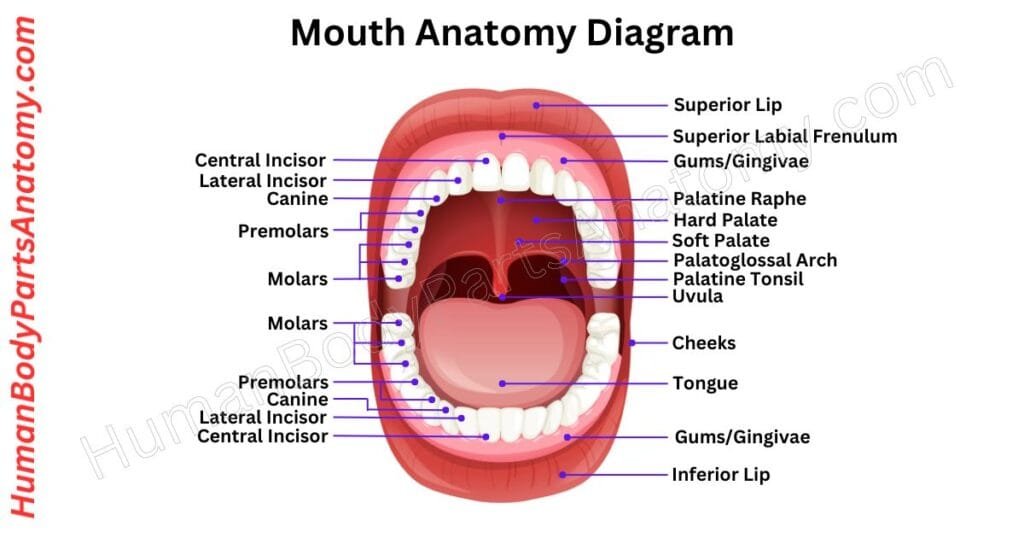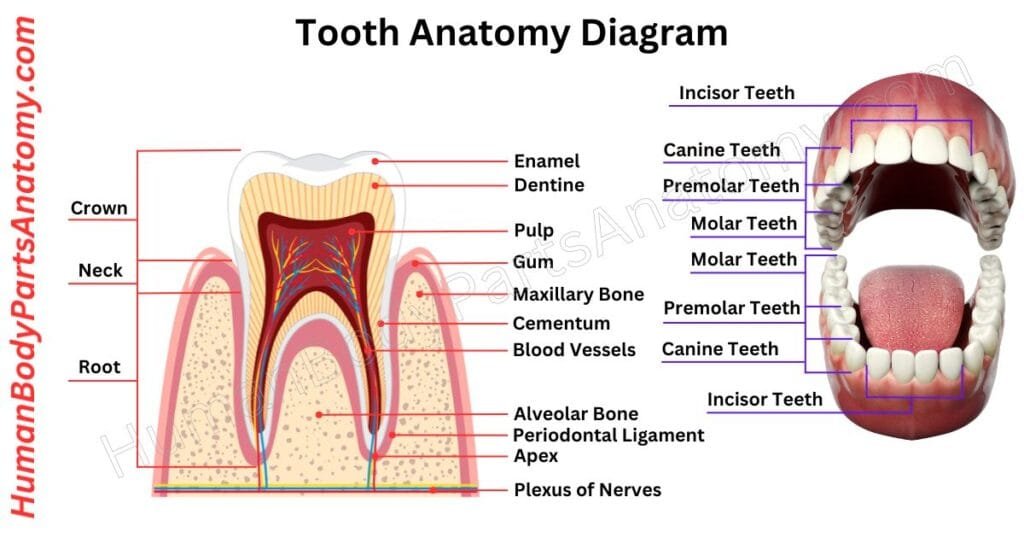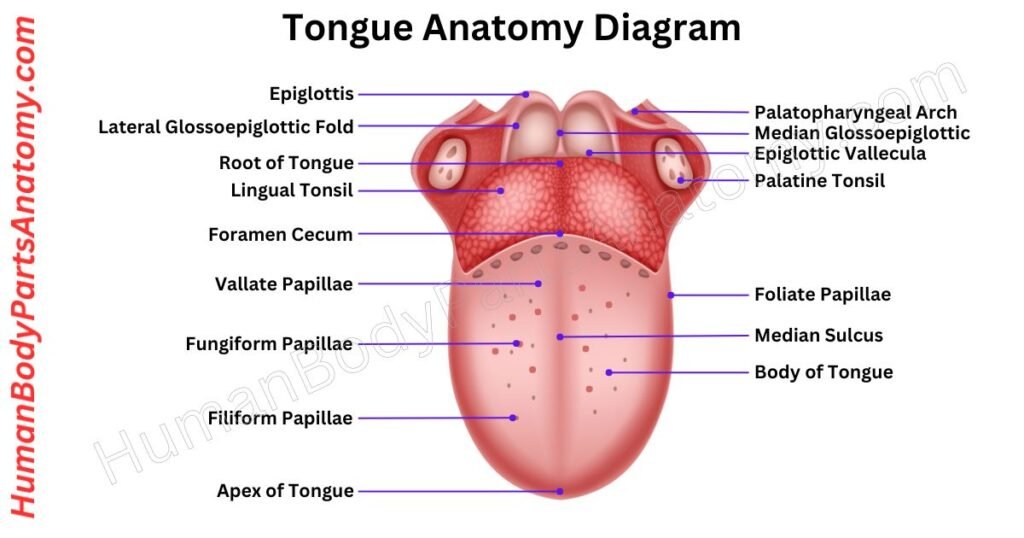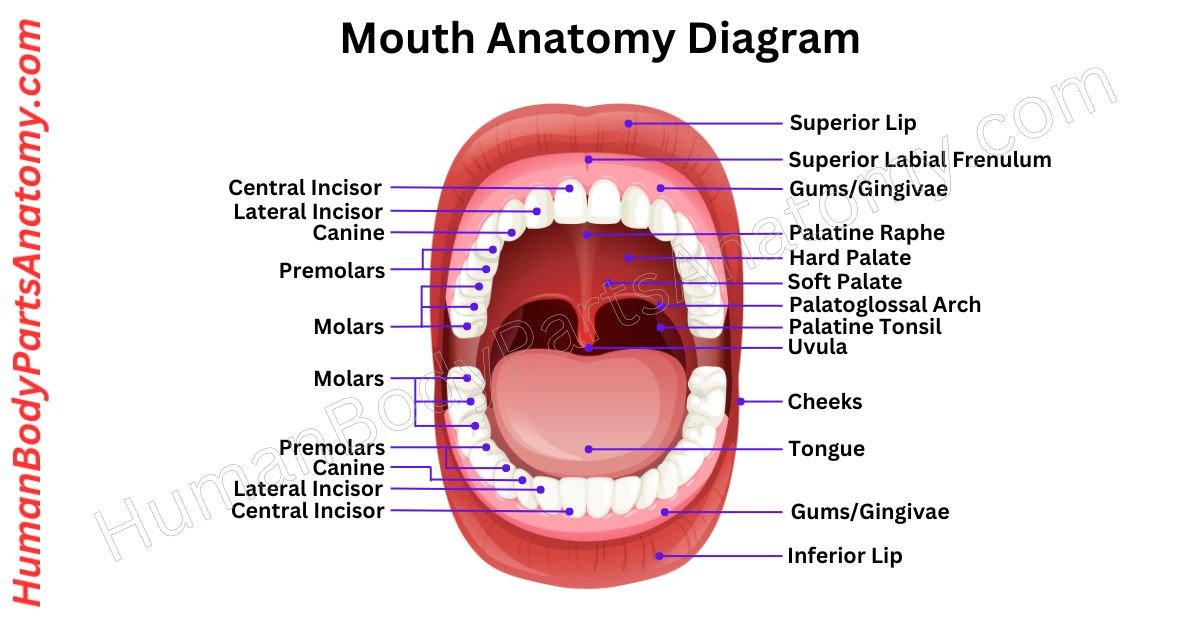Overview of Mouth Anatomy
The mouth is the starting point of the digestive system, where food enters, and saliva is produced. Inside the mouth is a special lining called the oral mucosa, which is soft and moist. This lining covers the inside of the mouth, including the gums, tongue, and other areas. Besides helping break down food, the mouth is also essential for speech. Although the main sounds of the voice come from the throat, the tongue, lips, and jaw are needed to create different words and sounds when we talk. The mouth anatomy has two main parts: the vestibule and the oral cavity. The vestibule is the area between the teeth and the lips, while the oral cavity proper is where the tongue sits and food gets chewed.
This space is always a bit wet because of the saliva. It helps with digestion and keeps everything smooth. The mouth also has teeth, which break down food. This article will show the mouth anatomy with their names, pictures & functions.
Mouth Anatomy Diagram

Parts of Mouth
- Lip
- Cheeks
- Gums
- Oral Cavity
- Teeth
- Tongue
- Salivary glands
- Palate
- Uvula
- Tonsils
- Pharynx
- Epiglottis
- Buccal Mucosa
- Periodontium
- Incisive Papilla
- Sublingual gland
- Submandibular gland
- Vestibule
Mouth Anatomy: Parts & Functions
Lip
Lips are a key feature of the face, helping with expressions, speaking, eating, kissing, and sensing touch. The top lip is called “labium superius oris,” and the bottom lip is called “labium inferius oris.” Each lip has a soft inner lining, a red middle part called the vermilion, and an outer skin layer.
The top lip starts from the folds on either side of the nose and goes down to the edge of the nostrils. The bottom lip stretches from the corners of the mouth to the crease between the lip and the chin.
Cheeks
The cheeks are the face area between the eyes and the jawline. They stretch from your nose to your ears. While they might seem simple on the outside, they are quite complex on the inside.
The outermost layer of the cheeks is the skin. The skin on your cheeks protects you from the outside world. It has tiny hairs that help keep your body temperature steady. The glands release oils to keep your skin healthy and fight off bacteria.
Under the skin, the cheeks have muscles, fat, and other tissues. The muscles in your cheeks help you chew food and make different facial expressions, like smiling or frowning. The fat gives your cheeks their shape and also helps to cushion them.
Gums
Gums, or gingiva, are the soft tissue that covers the lower jaw (mandible) and upper jaw (maxilla) inside your mouth. These tissues are important because they protect your teeth and help keep them in place.
Your gums are tightly attached to the bone underneath. This tight attachment helps them withstand the friction and pressure of chewing and other movements in your mouth.
Healthy gums are usually a coral-pink color in people with lighter skin tones. In some people, gums can be darker with more melanin, the pigment that gives color to skin.
Healthy gums are also firm and do not bleed easily. It seals around your teeth to protect the deeper layers of tissue from bacteria and other harmful substances.
These can be signs of inflammation if your gums change color to a deeper red, swell, or bleed more easily. A buildup of bacterial plaque often causes this inflammation.
Oral Cavity
The oral cavity sits below the nose at the front of the face. It has a roof, floor, and side walls. It opens at the front as the mouth opens and connects to the throat at the back through a narrow passage called the oropharyngeal isthmus. This passage is surrounded by soft tissue.
Several bones make up the structure of the oral cavity:
- the upper jawbones (maxillae)
- palate bones (palatine)
- temple bones (temporal)
- lower jawbone (mandible)
- wedge-shaped bone (sphenoid)
- horseshoe-shaped bone (hyoid)
The oral cavity is divided into two parts: the area in front of the teeth and lips (oral vestibule) and the area behind the teeth (oral cavity proper).
Salivary glands keep the oral cavity moist and help digest food by releasing enzymes that begin breaking down carbohydrates. The main salivary glands are the parotid, submandibular, and sublingual glands.
Teeth
Human teeth are part of the digestive system, helping to break down food by cutting, tearing, and crushing it. It makes it easier to swallow and digest. There are four types of teeth in the human mouth, each with a unique role:
- Incisors are the front teeth used for cutting food into smaller pieces.
- Canines are pointed teeth used for tearing food.
- Premolar teeth found between canines and molars help crush food.
- Molars are the larger teeth at the back of the mouth, also used for crushing food.
Teeth are rooted in the jawbones, either the upper jaw (maxilla) or the lower jaw (mandible), and are covered by gums. Teeth are made of different layers of tissue with varying levels of hardness.
Most adults have 32 permanent teeth. However, some people have fewer due to missing teeth (hypodontia), while others have more due to extra teeth (hypodontia).
Children usually have 20 primary (baby) teeth that grow from around 4 months old to about 6 years old. These baby teeth eventually fall out to make room for adult teeth.

Read More – Complete Guide to Tooth Anatomy: Learn Parts, Names & Diagram
Tongue
The tongue is a muscle in your mouth that helps you eat, talk, and taste food. It is covered in tiny bumps called taste buds, which let you taste sweet, sour, salty, and bitter. The tongue is always wet because of saliva, which also helps you taste and chew.
When you eat, the tongue helps move food around so you can chew it properly. It also enables you to swallow by pushing food down your throat.
In humans, the tongue plays a big role in talking, helping to form words and sounds. In other animals, it helps make different noises or vocalizations.

Read More – Tongue Anatomy: Complete Guide with Parts, Names, Functions & Diagram
Salivary glands
Saliva comes from the Salivary glands that make and release it whenever required. Humans have three big pairs of these salivary glands, plus lots of smaller glands. The main ones are the parotid glands found near your ears.
It contains a protein called alpha-amylase, which helps break down starch. Submandibular glands under your jaw help in digestion and lubrication.
Sublingual glands under your tongue keep your mouth smooth and slippery. They can make different types of saliva.
Our bodies make about 1.2 to 1.5 liters of saliva each day. When we need to produce saliva, our bodies use a part of our nervous system called the parasympathetic system. It sends signals to the glands with a chemical called acetylcholine, which makes us drool more.
Palate
The hard palate makes the front part of the roof of your mouth. It is a sturdy bone formed by the maxilla and palatine bones and separates your mouth from your nasal passages.
It has a top lining with a ciliated epithelium, while a squamous epithelium covers the bottom. The palate has bumpy ridges called rugae at the front to help move food.
There are three openings: the incisive canal in the middle front, the greater palatine foramen in the back, and the lesser palatine foramen further back. These let nerves and vessels pass through.
The soft palate is the back part of the roof of the mouth. It comprises muscles, connective tissue, and salivary glands, covered with a smooth, moist membrane. It doesn’t contain any bones and is flexible, allowing it to move and change shape.
The soft palate helps in several important tasks:
- It blocks the passage between the mouth and nose during swallowing, keeping food and drinks from entering the nose.
- It plays a role in speaking and breathing.
The soft palate has a small piece at the end called the uvula, which hangs in the back of the mouth. It connects to the tongue and pharynx through two arches, known as the palatoglossal and palatopharyngeal arches. The tonsils are found between these arches.
Uvula
The uvula is a small, cone-shaped piece of tissue that hangs from the back edge of the soft palate in your mouth. It contains connective tissue, a few small muscles, and some glands that make saliva. Silva is the fluid that keeps your mouth and throat moist.
The main role of the uvula is to keep your mouth and throat moist by producing saliva. It also plays a role in swallowing.
When you swallow food or drink, the uvula and the soft palate move backward to stop anything from going up into your nose. It is important because it helps keep food and drink moving in the right direction.
It helps you to protect yourself from choking. If something touches the soft palate near the uvula, it might make you gag or even vomit. This safety feature helps to ensure that nothing gets stuck in your throat.
Tonsils
The tonsils are organs stationed at the entrance to our throats. They help our body fight off germs. There are different types of tonsils: the adenoid tonsils, two tubal tonsils, two palatine tonsils, and the lingual tonsils.
When people talk about “tonsils” without specifying, they usually mean the palatine tonsils. These are at the back of the throat on either side.
These tonsils are part of our immune system. It works to catch and destroy harmful invaders like bacteria and viruses that we might breathe in or swallow.
They have special cells called M cells on their surface that grab onto these invaders and alert other immune cells, like B cells and T cells, to fight.
Inside the tonsils, B cells make memory cells and antibodies, which help our body remember how to fight off those germs if they return. So, the tonsils are like our body’s first line of defense against common illnesses like colds.
Pharynx
The pharynx sits in the middle of your neck and works like a junction for your digestive system and breathing.
It is like a funnel, wider at the top near your skull and narrower at the bottom around where your throat meets your chest. This structure lets you do important things like swallow food, breathe air, and make sounds with your voice.
There are three main sections:
- Nasal Pharynx: This part is all about breathing. It is behind your nose and connects with your nasal cavities.
- Oral Pharynx: This section continues from your mouth and helps move food toward your throat.
- Laryngeal Pharynx: This is where your throat meets your larynx. It is the final stop before food enters your esophagus and air enters your windpipe.
Understanding the pharynx is important because it involves basic functions like eating, breathing, and speaking.
Epiglottis
The epiglottis is a small, flexible piece of cartilage in your throat. Its job is to keep food and drinks from going down the wrong tube when you swallow.
Your voice box is normally open to let air in and out when you breathe. But when you eat or drink, the epiglottis closes over it, ensuring food and drinks go down the right way—into your stomach.
If the epiglottis doesn’t work right, food or drinks can go into your voice box and windpipe, causing you to cough and possibly choke. If food or drink goes down into your lungs, it can lead to serious health issues like pneumonia.
Buccal Mucosa
The buccal mucosa is the soft tissue that lines the insides of your cheeks and lips. The area inside your mouth makes contact with your teeth when your mouth is closed.
Periodontium
The periodontium is the connective tissue that surrounds and supports your teeth. It has four main parts: cementum, periodontal ligament (PDL), alveolar bone, and gingival tissue (gums).
These parts work together to hold your teeth in place, protect them from germs and bacteria in the mouth, and connect them to the jawbone.
Incisive Papilla
The incisive papilla is a small, rounded bump on the roof of the mouth, right behind the front teeth. It is in the middle part of the hard palate and is where the two sides of the palate meet.
The incisive papilla is important because it sits above a small cavity called the incisive fossa, which is linked to the nose and mouth during fetal development.
Submandibular Gland
The submandibular gland is one of the three big saliva makers in your mouth, along with the parotid and sublingual glands. It sits under your jawbone in a spot called the submandibular triangle.
It sends its spit out through a Wharton duct tube, which opens into your mouth near the frenulum.
This gland usually makes about 70% of your saliva when you are not eating. When you start munching, the parotid gland starts producing saliva.
You can find this gland by tracing your jawbone to where it meets your neck muscles and wrapping your fingers around it. It is surrounded by a covering called a capsule, like a protective layer.
Vestibule
The vestibule is the small space in your mouth between your lips or cheeks and your teeth or gums. It stays moist because of the spit (saliva) from the parotid salivary glands. These glands are located in front of your ears and behind your jaw.
Read More-
Lower Limb
- Complete Guide on Leg Anatomy with Parts, Functions & Diagram
- Complete Guide to Thigh Muscle Anatomy: Learn Parts, Names & Diagram
- Knee Anatomy: Complete Guide to Parts, Names, Functions & Diagram
- Femur Anatomy: Complete Guide with Parts, Names, Functions & Diagram
Upper Limb
- Complete Guide to Finger Anatomy with Parts, Names, Functions & Diagram
- Comprehensive Guide to Arm Anatomy: Parts, Names & Diagram
- Comprehensive Guide to Hand Anatomy: Parts, Functions & Diagram
- Ultimate Guide to Bicep Anatomy: Parts, Names, Functions & Diagram
- Shoulder Anatomy: Ultimate Guide to Parts, Names, Functions & Diagram
- Wrist Anatomy: Ultimate Guide to Parts, Names, Functions & Diagram
- Complete Guide to Nail Anatomy with all Parts, Names & Diagrams
Human Head
- Skull Anatomy: Complete Guide with Parts, Names, Functions & Diagram
- Ultimate Guide to Eye Anatomy: Parts, Structure, Functions & Diagram
- Tongue Anatomy: Complete Guide with Parts, Names, Functions & Diagram
- Complete Guide to Tooth Anatomy: Learn Parts, Names & Diagram
- Ultimate Guide to Ear Anatomy: Parts, Structure, Functions & Diagram
Organs
External Sources-
- Wikipedia
- KenHub
- Optometrists
- Cleveland Clinic
- American Academy of Ophthalmology

